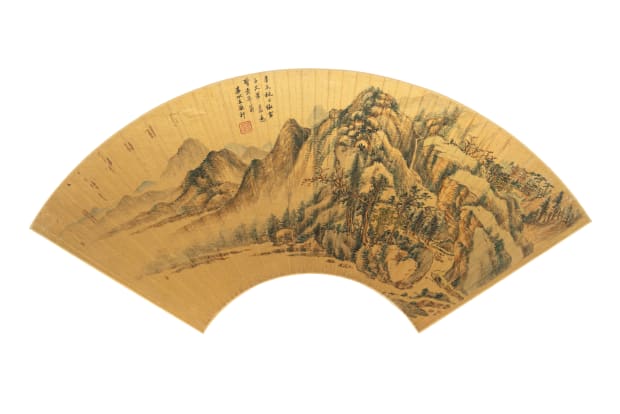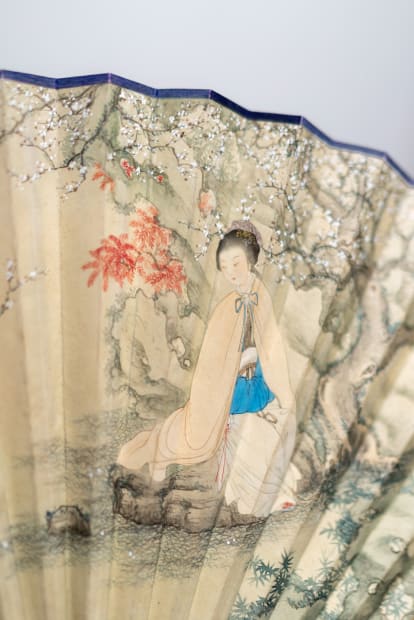-
Curator's introduction
In the context of East Asian culture, the fan, more than its mere practical use for fanning away heat and pests, was ingeniously embraced by artists as a canvas for artistic expression and as a miniature showcase. Each fan was a tiny cosmos, encapsulating the soul of its creator, and was often carried to various elegant gatherings for display. Not only did these fans demonstrate the aesthetic sensibilities and practices of literati artists but they also became powerful symbols of one's social standing. Aligned with China's tradition of integrating poetry, calligraphy, and painting, artists frequently inscribed and gifted these fans, marking exchanges and camaraderies within the literati community. As time progressed, even if the structural frames of the fans were compromised, their story-rich surfaces were often cherished, preserving fragments of historical memory. This sentiment captures a quintessential Eastern aesthetic philosophy — discovering renewed life and beauty amid continuous change.
Nevertheless, with the onset of the industrial age, the everyday use of fans began to diminish. However, the fan, as a form of artistic expression emblematic of Eastern aesthetic principles, was reconceptualized and endowed with renewed significance. It transitioned from a mere tool combating summer's heat to a medium expressing culture, aesthetics, and emotions. This shift reflects a subtle societal evolution, marking a revitalized appreciation and veneration for tradition.
—— Xian Fang
-
-
 Wang Yuanqi Landscape after Huang Gongwang, 仿黃公望筆意山水, 1691 signed Loushui Wang Yuanqi, dated xinwei (1691), autumn, with a dedication, inscribed "after Huang Zijiu (Huang Gongwang, 1269-1354)'s brush idea," with one seal of the artist, yuan qi ink and color on gold paper, fan leaf.
Wang Yuanqi Landscape after Huang Gongwang, 仿黃公望筆意山水, 1691 signed Loushui Wang Yuanqi, dated xinwei (1691), autumn, with a dedication, inscribed "after Huang Zijiu (Huang Gongwang, 1269-1354)'s brush idea," with one seal of the artist, yuan qi ink and color on gold paper, fan leaf. -
-
 Detail of Ye Renli and Yang Yinong, A Cut of Cold Fragrance, and Excerpt from The Notes of the Secluded Window in Regular Script
Detail of Ye Renli and Yang Yinong, A Cut of Cold Fragrance, and Excerpt from The Notes of the Secluded Window in Regular Script -
 Installation view of Tao Lengyue and Wang Fu'an Gazing the Mid-night Moon, and Calligraphy Excerpt of Song Dunwen, 1944
Installation view of Tao Lengyue and Wang Fu'an Gazing the Mid-night Moon, and Calligraphy Excerpt of Song Dunwen, 1944 -
Another highlight is the joint work between Tao Lengyue (1895-1985) and Wang Fu’an(1880-1960), Ink Plum, Ode to the Western Capital in Seal Script. Only then do we realize that Tao's mastery of his representative painting techniques, influenced by Western art, is deeply rooted in his profound traditional foundation. Wang‘s iron-line seal script is refined to perfection, arguably reaching the pinnacle of decorative qualities in modern seal script. Further enriching our collection is a piece by the talented female artist of the 20th century, Ye Renli, accompanied by calligraphy work from her contemporary, Yang Yinong, titled A Cut of Cold Fragrance, Excerpt from The Notes of the Secluded Window in Regular Script. This reflects the exceptional artistic accomplishments of female artists during the Republican era. She generously inscribed and gifted her work to others, demonstrating the awakening of women's consciousness in the new era. Beyond the exquisite calligraphy and painting on the fan leaves, many fan frames also came from the hands of renowned artists, with their delicate carvings further exemplifying the refined aesthetic appreciation of the literati at that time.
We cordially invite you to FQM to immerse yourself in these historically rich masterpieces, collaboratively exploring the narratives and cultural tales they encapsulate. Revel in the harmonious blend of ancient wisdom and contemporary innovation, and experience the singular beauty and allure that fan artistry, a distinctive Eastern tradition, has to offer.
15 September - 18 November 2023
Join our mailing list
* denotes required fields
We will process the personal data you have supplied to communicate with you in accordance with our Privacy Policy. You can unsubscribe or change your preferences at any time by clicking the link in our emails.






